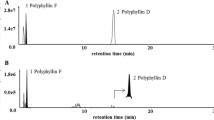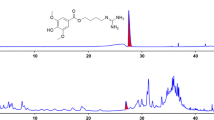Abstract
Objective
The present study investigates the anti-obesity activity of Luffa cylindrica in progesterone induced obesity model.
Method
Swiss albino mice were grouped into 7 (n = 6). Obesity was induced by administration of progesterone (10 mg/kg s.c.) for 28 days. Normal group received ad libitum and water. Disease control, positive control and treatment groups received progesterone (10 mg/kg s.c.). Further positive control group received Orlistat (10 mg/kg p.o). Treatment groups received hydro-alcoholic and fractionation extract of Luffa cylindrica at doses 400, 200, 100 mg/kg b.w. Food and water intake were recorded daily, Body weight, BMI and blood glucose were checked weekly. On completion of the study, animals were sacrificed and blood serum being utilized to accesses in vitro to estimate the various biochemical parameters. Serotonin levels and antioxidant biomarkers were also estimated. Histopathology of liver and adipose tissue was studied.
Result
After the 28 days of treatment with plant extract and fraction, it was observed to improve the progestrogen-induced obesity by improving BMI, body weight, brain serotionin, locomotor activity, blood glucose level, anti-oxidant biomarkers, and lipid profile.
Conclusion
After assimilating the In vivo and in vitro studies Luffa cylindrical extract highlighted the antilipidemic, anti-hyperglycaemic, antioxidant potential in hormone-induced obesity.


Similar content being viewed by others
Change history
12 May 2023
This article has been retracted. Please see the Retraction Notice for more detail: https://doi.org/10.1007/s40200-023-01233-1
Abbreviations
- BMI:
-
Body Mass Index
- BW:
-
Body Weight
- TG:
-
Triglycerides
- TC:
-
Total Cholesterol
- HDL:
-
High Density Lipoprotein
- LDL:
-
Low Density-Lipoprotein
- VLDL:
-
Very Low Density Lipoprotein
- SGPT:
-
Serum Glutamic Pyruvic Transaminase
- SGOT:
-
Serum Glutamic Oxaloacetic Transminase
- LC extract:
-
Luffa cylindrical extract
- Fraction of LC:
-
Luffa cylindrical extract fraction group
References
Grundy SM. Obesity, metabolic syndrome, and cardiovascular disease. J Clin Endocrinol Metab. 2004;89(6):2595–600.
Lavie CJ, McAuley PA, Church TS, Milani RV, Blair SN. Obesity and cardiovascular diseases: implications regarding fitness, fatness, and severity in the obesity paradox. J Am Coll Cardiol. 2014;63(14):1345–54.
Piché M-E, Poirier P, Lemieux I, Després J-P. Overview of Epidemiology and Contribution of Obesity and Body Fat Distribution to Cardiovascular Disease: An Update. Prog Cardiovasc Dis. 2018;61:103–13.
Ng M, Fleming T, Robinson M, Thomson B, Graetz N, Margono C, et al. Global, regional, and national prevalence of overweight and obesity in children and adults during 1980 2013: a systematic analysis for the global burden of disease study 2013. Lancet. 2014;384:766–81.
Keys A, Fidanza F, Karvonen MJ, Kimura N, Taylor HL. Indices of relative weight and obesity. Int J Epidemiol. 2014;43(3):655–65.
Poirier P, Alpert MA, Fleisher LA, Thompson PD, Sugerman HJ, Burke LE, et al. Cardiovascular evaluation and management of severely obese patients undergoing surgery: a science advisory from the American Heart Association. Circulation. 2009;120(1):86–95.
Poirier P, Giles TD, Bray GA, Hong Y, Stern JS, Pi-Sunyer FX, et al. Obesity and cardiovascular disease: pathophysiology, evaluation, and effect of weight loss: an update of the 1997 American Heart Association scientific statement on obesity and heart disease from the obesity Committee of the Council on nutrition, physical activity, and metabolism. Circulation. 2006;113(6):898–918.
Wormser D, Kaptoge S, Di Angelantonio E, Wood AM, Pennells L, Thompson A, et al. Separate and combined associations of body-mass index and abdominal adiposity with cardiovascular disease: Emerging Risk Factors collaborative analysis of 58 prospective studies. Lancet. 2011;377(9771):1085–95.
Bastien M, Poirier P, Lemieux I, Després JP. Overview of epidemiology and contribution of obesity to cardiovascular disease. Prog Cardiovasc Dis. 2014;56(4):369–81.
Asarian L, Geary N. Modulation of appetite by gonadal steroid hormones. Philos Trans R Soc Lond Ser B Biol Sci. 2006;361(1471):1251–63.
Carlson MJ, Thiel KW, Yang S, Leslie KK. Catch It Before It Kills: Progesterone, Obesity, and the Prevention of Endometrial Cancer. Discov Med. 2012;14(76):215–22 PMCID: PMC3964851.
Amatayakul K, Sivasomboon B, Thanangkul O. A study of the mechanism of weight gain in medroxyprogesterone acetate users. Contraception. 1980;22(6):605–22.
Wallace JM, Shively CA, Clarkson TB. Effects of hormone replacement therapy and social stress on body fat distribution surgically postmenopausal monkeys. Int J Obes. 1999;23:518–27.
Bäckström T. Symptoms related to the menopause and sex steroid treatments. CIBA Found Symp. 1995;191:171–80 discussion 180-6.
Crammer JL. Premenstrual depression, cortisol and oestradiol treatment. Psychol Med. 1986;16(2):451–5.
Bethea CL, Gundlah C, Mirkes SJ. Ovarian steroid action in the serotonin neural system of macaques. Novartis Found Symp. 2000;230:112–30.
Kaur G, Kulkarni SK. Evidence for serotonergic modulation of progesterone-induced hyperphagia, depression and algesia in female mice. Brain Res. 2002;943(2):206–15.
WHO. Obesity: preventing and managing the global epidemic. WHO Technical Report Series number 894. Geneva: WHO; 2000.
Lee YS, Cha BY, Saito K, Choi SS, Wang XX, Choi BK, et al. Effects of a Citrus depressa Hayata (shiikuwasa) extract on obesity in high-fat diet- induced obese mice. Phytomedicine. 2011;18(8–9):648–54.
Murase T, Misawa K, Minegishi Y, Aoki M, Ominami H, Suzuki Y, et al. Coffee polyphenols suppress diet-induced body fat accumulation by downregulating SREBP- 1c and related molecules in C57BL/6J mice. Am J Physiol Endocrinol Metab. 2011;300(1):E122–33.
Gupta N, Hallman DM, Dumuid D, Vij A, Rasmussen CL, Jørgensen MB, et al. Movement behavior profiles and obesity: a latent profile analysis of 24-h time-use composition among Danish workers. Int J Obes. 2020;44:409–17. https://doi.org/10.1038/s41366-019-0419-8.
AZEEZ MA, BELLO OS, Omobola A. Traditional and medicinal uses of Luffa cylindrica :a Review. J Med Plants Studies. 2013;1(5):102–11.
Partap S, Kumar A, Sharma NK, Jha KK. Luffa Cylindrica: An important medicinal plant. J Nat Prod Plant Resour. 2012;2(1):127–34.
Khare CP. Indian medicinal plants: an illustrated dictionary. Springer Science & Business Media; 2008.
Khanal P, Patil BM. Gene ontology enrichment analysis of α-amylase inhibitors from Duranta repens in diabetes mellitus. J Diabetes Metab Disord. 2020. https://doi.org/10.1007/s40200-020-00554-9.
Nderitu KW, Mwenda NS, Macharia NJ, Barasa SS, Ngugi MP. Antiobesity activities of Methanolic extracts of Amaranthus dubius, Cucurbita pepo, and Vigna unguiculata in progesterone-induced obese mice. Evid Based Complement Alternat Med. 2017;2017:4317321.
Gargiulo S, Gramanzini M, Megna R, Greco A, Albanese S, Manfredi C, et al. Evaluation of Growth Patterns and Body Composition in C57Bl/6J Mice Using Dual Energy X-Ray Absorptiometry. BioMed Res Int. 2014;2014(253067):11. https://doi.org/10.1155/2014/253067.
Schlumpf M, Lichtensteiger W, Langemann H, Waser PG, Hefti F. A fluorometric micromethod for the simultaneous determination of serotonin, noradrenaline and dopamine in milligram amounts of brain tissue. Biochem Pharmacol. 1974;23(17):2437–46.
Clark MK, Dillon JS, Sowers M, Nichols S. Weight, fat mass, and central distribution of fat increase when women use depot medroxyprogesterone acetate for contraception. Int J Obesity. 2005;29:1252–8.
Shirling D, Ashby JP, Baird JD. Effect of progesterone on lipid metabolism in the intact rat. J Endocrinol. 1981;90(2):285–94.
Emans JB, Jones AL. Hypertrophy of liver cell smooth surfaced reticulum following progesterone administration. J Histochem Cytochem. 1968;16(9):561–71. https://doi.org/10.1177/16.9.561.
Khanal P, Patil BM. Integration of network and experimental pharmacology to decipher the antidiabetic action of Duranta repens L. J Integr Med. 2020;S2095–4964(20):30109–6. https://doi.org/10.1016/j.joim.2020.10.003 Epub ahead of print.
Khanal P, Patil BM, Chand J, Naaz Y. Anthraquinone Derivatives as an Immune Booster and their Therapeutic Option Against COVID-19. Nat Prod Bioprospect. 2020;10(5):325–35. https://doi.org/10.1007/s13659-020-00260-2 Epub 2020 Aug 8. PMID: 32772313; PMCID: PMC7414902.
Khanal P, Duyu T, Patil BM, Dey YN, Pasha I, Wanjari M, et al. Network pharmacology of AYUSH recommended immune-boosting medicinal plants against COVID-19. J Ayurveda Integr Med. 2020. https://doi.org/10.1016/j.jaim.2020.11.004 Epub ahead of print. PMID: 33250601; PMCID: PMC7687402.
Patil R, Chikhale R, Khanal P, Gurav N, Ayyanar M, Sinha S, et al. Computational and Network Pharmacology Analysis of Bioflavonoids as Possible Natural Antiviral Compounds in Covid-19. Inform Med Unlocked. 2020;22:100504. https://doi.org/10.1016/j.imu.2020.100504.
Duyu T, Khanal P, Khatib NA, Patil BM. Mimosa pudica modulates Neuroactive ligand-receptor interaction in Parkinson’s disease. Indian J Pharm Educ Res. 2020;54(3):732–9.
Khanal P, Patil BM. In vitro and in silico anti-oxidant, cytotoxicity and biological activities of Ficus benghalensis and Duranta repens. Chinese Herbal Med. 2020;12(4):406–13.
Acknowledgements
The authors are thankful to Prof. Dr. S. S. Jalalpure Principal, KLE college of Pharmacy, Belagavi, Karnataka, India for providing necessary facilities, Prof. Dr. B. M. Patil and HOD for their suggestions. Further, we thank KAHER for cosidering for research funding the project.
Author information
Authors and Affiliations
Contributions
All the Authors are designed equally involved in the study and the experiments and Reviewed the written drafted the manuscript. Contributed in conduct of the experiments, performed data analysis. The author(s) read and approved the final manuscript.
Corresponding author
Ethics declarations
Conflict of interest
The authors declare no conflict of interest.
Additional information
Publisher’s note
Springer Nature remains neutral with regard to jurisdictional claims in published maps and institutional affiliations.
This article has been retracted. Please see the retraction notice for more detail: https://doi.org/10.1007/s40200-023-01233-1"
Rights and permissions
Springer Nature or its licensor (e.g. a society or other partner) holds exclusive rights to this article under a publishing agreement with the author(s) or other rightsholder(s); author self-archiving of the accepted manuscript version of this article is solely governed by the terms of such publishing agreement and applicable law.
About this article
Cite this article
D’silva, W.W., Biradar, P.R. & Patil, A. RETRACTED ARTICLE: Luffa cylindrica: a promising herbal treatment in progesterone induced obesity in mice. J Diabetes Metab Disord 20, 329–340 (2021). https://doi.org/10.1007/s40200-021-00749-8
Received:
Accepted:
Published:
Issue Date:
DOI: https://doi.org/10.1007/s40200-021-00749-8




